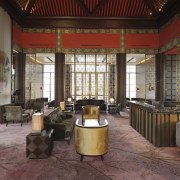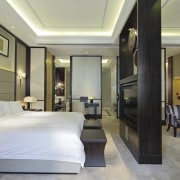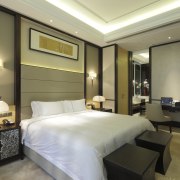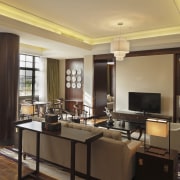Eastern splendour
the Eadry Royal Garden Hotel refit in Haikou by BLVD relects Chinese imperial design
Time and geographical shifts are apt to have unhappy consequences for pure design forms, and the high style of Qing Dynasty imperial architecture in Northern China is no exception. Passing decades and fashions have seen the famous grand palaces and gardens in the north misrepresented elsewhere in a looser Southeast Asian-style or even a more simplistic Mediterranean look.
Original Chinese royal architecture and garden design provided the inspiration for the reinvented five-star Eadry Royal Garden Hotel in Haikou. The hotel was first built to celebrate the richness of Chinese architecture, but its proportions had been ill-considered and the result was more like a popular take on the original, with little attention paid to historical accuracy. Architect and interior design firm BLVD International undertook the revamp, with interior designer Honglei Liu at the helm.
"My goal was to introduce the magnificence of royal garden architecture to South China. However, at the same time I had to marry this refined style with the comfort and convenience expected by guests at a five-star hotel. To achieve this I had to look to the past and also to the trends in present day, five-star hospitality."
The work was detailed and comprehensive a new grand lobby was built, and the bar behind it substantially reworked. Along with new restaurants and facilities, the original ground-level gardens were dropped to basement level. While this meant that considerable structural and design work was required, the drama and enjoyment of these natural, yet symmetrical, oases was enhanced, Liu says.
"I wanted to create an environment where guests would feel they were in a truly regal space not some folk, pastiche or imitation product."
"The scale and the proportions of one of the largest temples in China was selected as a model for this scheme and then carefully manipulated to fit the three-dimensional spaces required for the hotel," says Liu. "For example, in the new main lobby, the rhythm of the column spacing was changed to create rectangular spaces rather than the square forms celebrated in classic courtyard architecture. At the same time, we sought to retain the feel of the traditional wooden structure."
Modern materials such as reinforced concrete were used, but the scale of the columns and beams matches that of the old wood construction.
"In typical royal garden architecture white stucco walls, grey stone and different shades of red were combined with exquisite and extensive decoration," says the designer. "I retained the basic principles but in simpler forms and with more restrained colour palettes to suit the contemporary feel that I wanted for the hotel."
The existing three-level lobby bar building set behind the lobby building and at the centre of the plan was substantially reconsidered. The top tier was removed and then rebuilt with accentuated up-turned eaves and an improved, classically accurate proportional relationship with the two lower tiers.
While the look has been transformed to create an authentic atmosphere, design concessions have been made to modern architecture. The ornate carved and decorated ceilings seen in ancient imperial palaces have been replaced here with simpler dark timber rafters with a deep red soffit. This creates a contrasting, contemporary pattern with minimal and, at times, no decoration.
The corridor and balcony balustrades have also been simplified to feature a modern Chinese screen pattern in a single colour.
"I also wanted to introduce the concept of a quadrangular courtyard si heyuan in Chinese to South China and to the Haikou project. A primary function of a five-star hotel is to offer privacy and solitude, so I tried to allow appreciation of the garden from the guest rooms in an enclosed or partially enclosed fashion to evoke the concept of heaven and human, united as one."
This was in part why Liu dropped the identical courtyards by an entire level so that guests could look straight out onto these peaceful spaces.
While echoing the grand, old-world feel of regal structures in Northern China, the hotel also reflects the expectations and needs of guests today.
"As well as respecting a strictly classic doctrine, the renovation was influenced by modern design trends," says Liu. "For example, glazed doors and screens were introduced between the guest rooms and the courtyards protecting the privacy and calmness of the individual rooms."
To further develop this idea, in some areas portions of the roof structure were removed to create new courtyards for some of the guest suites.
"The traditional royal garden architecture has reappeared most recently only in North China and in the regions of Beijing. One of the most important challenges in Haikou was to create something new of historical and cultural significance.
"I believe that what I have created is not an exact copy, but a personal interpretation that combines ancient and modern a new stage of the original architecture," says Liu. "We cannot slavishly copy history but we can design to make it reappear."
Credit list
Interior designer
Landscaping
Lighting
Bathroom fittings
Story by: Charles Moxham
Home kitchen bathroom commercial design
Diving into nature
Classic looks, contemporary efficiency
Personality plus
















